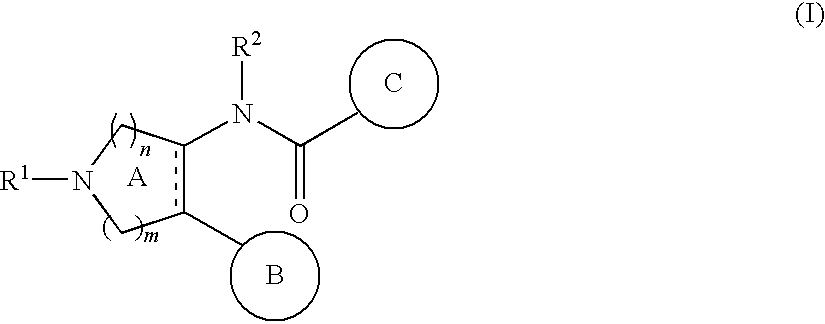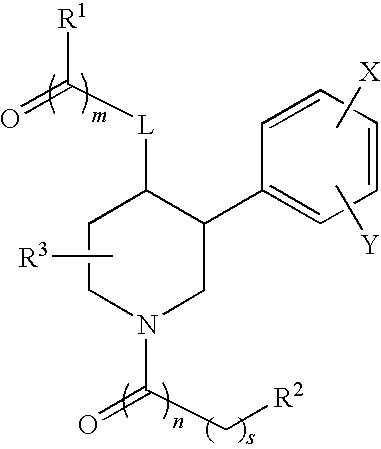Nitrogen-containing heterocyclic compound and use thereof
a heterocyclic compound and nitrogen-containing technology, applied in the field of nitrogen-containing heterocyclic compound, can solve the problems of difficult to provide them as practical prophylactic drugs or therapeutic drugs, and low activity of known peptidic nk-2 antagonists, and achieves safe as a pharmaceutical agent, low toxicity, and superior tachykinin receptor antagonistic action.
- Summary
- Abstract
- Description
- Claims
- Application Information
AI Technical Summary
Benefits of technology
Problems solved by technology
Method used
Image
Examples
reference example 1
tert-butyl (3R*,4R*)-4-({[3,5-bis(trifluoromethyl)phenyl]carbonyl}amino)-3-(3,4-dichlorophenyl)piperidine-1-carboxylate
(Step 1)
[0390]To a solution of ethyl isonicotinate (151 g) in ethyl acetate (1000 mL) was added methyl iodide (126 mL), and the mixture was stirred at 80° C. for 3 hr. The reaction mixture was cooled, and the orange precipitate was collected by filtration. The precipitate was suspended in ethanol (1000 mL), sodium borohydride (37.8 g) was added with cooling at −40° C., and the mixture was stirred at room temperature for 2 hr. The reaction mixture was poured into water, and ethanol was evaporated under reduced pressure. The resultant product was extracted with ethyl acetate-tetrahydrofuran, the organic layer was dried, and the solvent was evaporated under reduced pressure. The residue was distilled under reduced pressure to give ethyl 1-methyl-1,2,3,6-tetrahydropyridine-4-carboxylate (85.8 g, 51%) as a pale yellow oil.
[0391]Boiling point: 64-77° C. (1 mmHg)
[0392]1H-N...
reference example 2
tert-butyl 4-({[3,5-bis(trifluoromethyl)phenyl]carbonyl}amino)-3-(3,4-dichlorophenyl)piperidine-1-carboxylate (cis / trans mixture)
(Step 1)
[0401]To a solution of sodium hydride (60% in oil, 6.56 g) in m-xylene (100 mL) was slowly added ethanol (15.7 mL) at 0° C. and then diethyl oxalate (32.0 g) was added. Furthermore, a solution of ethyl 3,4-dichlorophenylacetate (51.0 g) in m-xylene (30 mL) was added at 0° C., and the mixture was stirred at room temperature for 14 hr. To the reaction mixture was added 37% aqueous formalin solution (140 mL) at room temperature, and the mixture was stirred at room temperature for 1 hr. Furthermore, potassium carbonate (115 g) was added at room temperature, and the mixture was stirred at room temperature for 1 hr. The insoluble material was filtered off, and the filtrate was partitioned between ethyl acetate (500 mL) and water (500 mL). The organic layer was separated, washed with brine and dried, and the solvent was evaporated under reduced pressure. ...
reference example 3
tert-butyl (3R*,4R*)-3-(3,4-dichlorophenyl)piperidine-4-[(phenylcarbonyl)amino]-1-carboxylate
[0415]Using the compound obtained in Reference Example 1, step 4 and benzoyl chloride, and by the reaction and purification in the same manner as in Reference Example 2, step 7, the title compound was obtained.
[0416]MS (ESI+): 393 (M-tBu+2H)
PUM
 Login to View More
Login to View More Abstract
Description
Claims
Application Information
 Login to View More
Login to View More - R&D
- Intellectual Property
- Life Sciences
- Materials
- Tech Scout
- Unparalleled Data Quality
- Higher Quality Content
- 60% Fewer Hallucinations
Browse by: Latest US Patents, China's latest patents, Technical Efficacy Thesaurus, Application Domain, Technology Topic, Popular Technical Reports.
© 2025 PatSnap. All rights reserved.Legal|Privacy policy|Modern Slavery Act Transparency Statement|Sitemap|About US| Contact US: help@patsnap.com



